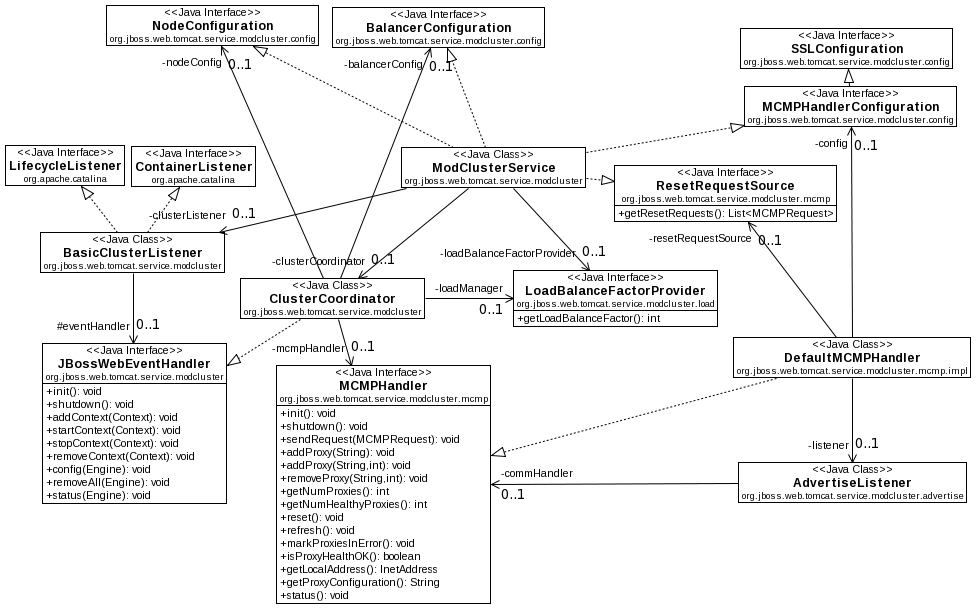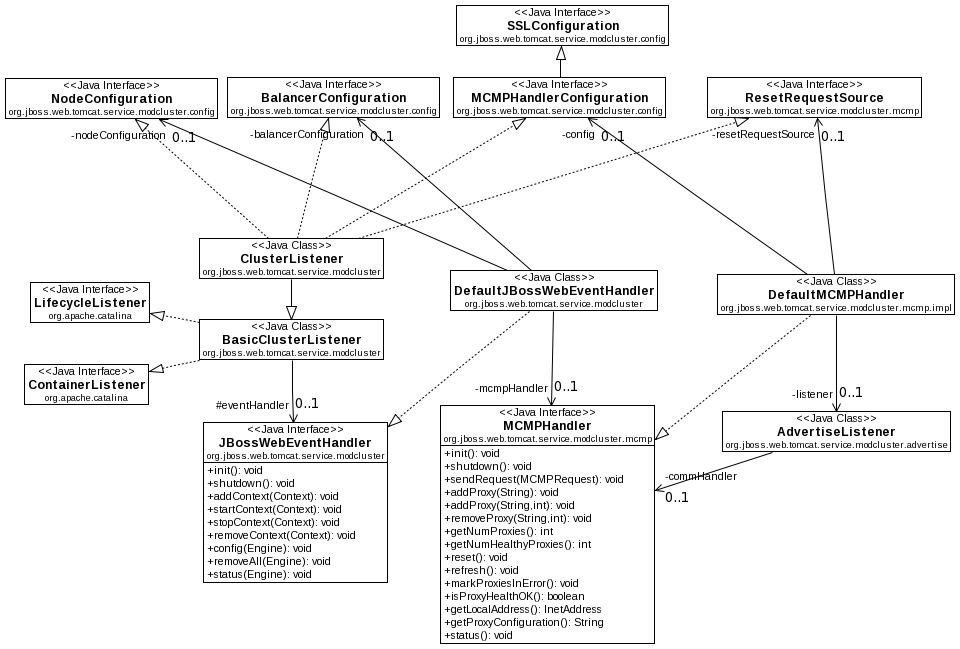Mod-Cluster Integration in JBoss AS6
Overall container JIRA for this: JBAS-5658. A number of child issues are defined below; several of these child issues also have subtasks.
Discussion Links
Elements:
Configuration
Things to configure
Node
Balancer
HASingleton election
load balance policy (what metrics drive the decision)
ClusterListener handles the first 2 of these; is that how we want it?
Doing the rest requires MC-based config
Lifecycle/Deployment events (JBAS-5669)
ClusterListener handles this well
Periodic events
ClusterListener uses JBossWeb background thread from Engine
Communication with httpd side
ClusterListener has good code for this; would be very nice to re-use (JBNATIVE-60)
Extract from the ClusterListener class into a separate class?
Use an interface so the HASingleton-based version can add behavior
mod_cluster advertisement
JBossWeb has code for this
HASingleton (JBAS-5659)
HASingletonSupport subclass
Primary task is polling nodes for load information, aggregating, feeding to mod_cluster
Also detects intra-cluster comm failures, alternate mechanism to notify mod_cluster
Gateway to mod_cluster for all other messages (lifecycle/deployment)?
When not functioning as singleton master, it acts as RPC handler for requests from master
HASingleton master election policy (JBAS-5660)
Allow a master per domain
Node that can't reach mod_cluster shouldn't be master
Handle the above by putting a small data object in DRM instead of simple string
Load Manager (JBAS-5661)
Gathers information from various sources of metrics
Aggregates into an overall metric
Includes a time decay function
Load metrics (JBAS-5664)
Interface; impl's plug into the load manager
Each impl handles a metric or set of related metrics (e.g. web requests, web sessions, VM/machine metrics, transactions)
Need to figure how to integrate into various subsystems that provide data
Questions:
Individual nodes communicate lifecycle/deployments events directly to mod_cluster, or via HASingleton?
We want all nodes to be able confirm their ability to communicate with mod_cluster, so even with HASingleton nodes need to be able to contact mod_cluster themselves
Answer: A STATUS message sent by the HASingleton can trigger a ping/pong check of a different node, so there is no need for each node to communicate with mod_cluster. So, route all messages through the singleton.
-
High Level Design
Explanation
The four XXXConfiguration interfaces basically package the getters of all the configuration properties exposed by the JBoss Web ClusterListener class. NodeConfiguration is the info about a particular node that gets passed to mod_cluster; BalancerConfiguration is non-node specific stuff like sticky session configuration that gets passed to mod_cluster. SSLConfiguration configures any JSSESocketFactory; subinterface MCMPHandlerConfiguration includes the other properties that govern how to discover (via static config or an AdvertiseListener and communicate with mod_cluster. I've divided these into different interfaces so different clients (e.g. JSSESocketFactory only see the necessary properties. Use interfaces so different classes can implement (e.g. ModClusterService here but possibly the standalone ClusterListener). See http://wiki.jboss.org/wiki/ClusterListener for a description of the relevant configuration properties.
ModClusterService forms the core. It's function is pretty simple:
Expose the 4 XXXConfiguration interfaces; expose setters to allow centralized configuration via a -beans.xml file.
Create (or have dependency injected) the other components; wire them together as needed.
Expose the main management interface (JMX, embedded console)
BasicClusterListener implements the Tomcat LifecycleListener and ContainerListener interfaces. The core event listener code from the JBoss Web ClusterListener class. When it receives events it calls into
JBossWebEventHandler exposes the various operations that are implemented as protected methods in the JBoss Web ClusterListener class. I make this an interface to support different implementations in a clustered, non-clustered or standalone environment.
ClusterCoordinator is the HASingleton. It implements JBossWebEventHandler so it receives events from BasicClusterListener. When it receives events it either makes RPC calls to whichever of its peers is the coordinator, or if its the coordinator it drives the process of gathering load data from around the cluster and sending status messages to mod_cluster. Not shown on the diagram is the expectation that ClusterCoordinator is a subclass of the HASingletonSupport class and has injected into it an HASingletonElectionPolicy impl and an HAPartition.
Each node's ClusterCoordinator gets the current load balance factor from a LoadBalanceFactorProvider. The implementation of that interface is a whole subsystem.
If a ClusterCoordinator is the HASingleton master, it needs to communicate with the http side. It does this through an implementation of the MCMPHandler interface.
DefaultMCMPHandler is the standard implementation of MCMPHandler. It basically encapsulates the proxy management and request sending code in the JBoss Web ClusterListener. If so configured, it creates an AdvertiseListener to listen for multicast service advertisements by mod_cluster instances.
MCMPRequest (not shown except as a param or return type) is a simple data object that encapsulates an enum identifying the request type (CONFIG, ENABLE-APP, STATUS, etc), the wildcard boolean, and the Map<String, String> of parameters.
ResetRequestSource is a bit of an oddity that came with factoring the proxy management code in DefaultMCMPHandler out of ClusterListener. The proxy mgmt code during periodic status checks checks to see if any of its proxies to mod_cluster were in error state; if so it would tell the listener (via reset(int pos) to send a set of messages to that mod_cluster instances to reestablish configuration state. That reset(int pos) call was problematic in decoupling the proxy mgmt code, as it exposes internal details of the proxy manager (the pos). So, instead I created an interface ResetRequestSource an instance of which is injected into an MCMPHandler. When the MCMPHandler discovers it needs to reset a proxy, it asks the ResetRequestSource to provide a List<MCMPRequest> of commands that need to be invoked on mod_cluster to reset the node's state. Any class with access to the Tomcat Server object and to the NodeConfiguration and BalancerConfiguration could play this role.
Other Uses of the Same Abstractions?
The following shows how many of the same abstractions can be used in standalone JBoss Web. Not surprising since they mostly came from JBoss Web's ClusterListener. This diagram basically represents a possible factoring of the current ClusterListener into separate classes to allow code reuse in the AS. Ignore the package names below; they can be changed:
The XXXConfiguration interfaces are same as described above. Here they are implemented by ClusterListener instead of ModClusterService.
ClusterListener plays the role played by ModClusterService in the AS, since there is no -beans.xml.
Expose the 4 XXXConfiguration interfaces; expose setters to allow centralized configuration, here via the Listener element in server.xml.
Create the other components; wire them together as needed.
Expose any management interface (JMX)
ClusterListener is actually a subclass of BasicClusterListener (discussed above), which contains the actual event listener implementation.
ClusterListener provides to its BasicClusterListener superclass the JBossWebEventHandler impl to use. Here it is DefaultJBossWebEventHandler which basically just encapsulates the relevant methods that are in the current ClusterListener impl.
MCMPHandler interface and DefaultMCMPHandler impl are the same as is used in the AS cluster discussion above.
Here the ClusterListener acts as the ResetRequestSource.


Comments